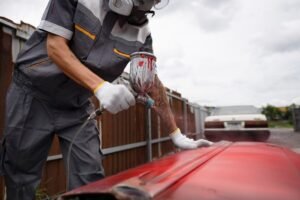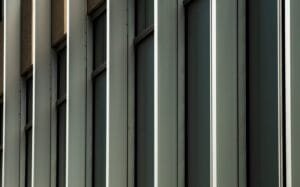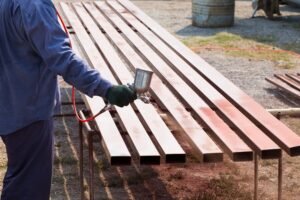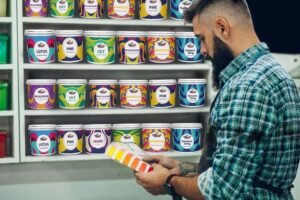Introduction to Painting Wood and Metal Surfaces
Surface painting is a crucial aspect in maintaining and enhancing the longevity of both wood and metal objects. The importance of applying paint cannot be overstated, as it serves multiple functions that go beyond mere aesthetics. A well-painted surface significantly improves the visual appeal of items, making them more attractive in both personal and professional settings. This is particularly relevant for furniture, fixtures, and art pieces, where color and finish can influence perception and value.
In addition to enhancing aesthetic appeal, painting serves as a protective barrier against environmental factors that can lead to damage. Wood is susceptible to moisture, insects, and decay, while metal surfaces are prone to corrosion and rust. A quality coat of paint, especially specialized finishes like mithila paints, can mitigate these risks effectively. By sealing surfaces, paint helps prevent moisture infiltration and shields materials from harmful elements, thereby increasing their durability and lifespan.
Moreover, the applications of surface painting extend to a wide range of industries, including construction, automotive, and even arts and crafts. Paint is also vital in restoring and preserving historical artifacts, as it can replicate period finishes while providing necessary protection. The benefits of proper surface finishing are manifold, encompassing not only practical advantages but also contributing to the overall value of items.
Understanding the significance of surface painting engenders an appreciation for the craftsmanship involved in both the selection and application of paints. In light of this, it is essential to consider not just the type of paint used, but also the techniques employed to achieve a lasting finish. A comprehensive approach ensures that the benefits of surface painting are maximized, safeguarding the investment invested in wood and metal surfaces.

Understanding the Different Types of Paints
When it comes to painting wood and metal surfaces, understanding the various types of paints available is critical to achieving a durable and aesthetically pleasing finish. Among the most common types are water-based and oil-based paints, as well as specialty options like rust-resistant and enamel paints.
Water-based paints, such as acrylics, are known for their ease of use and quick drying times. They are ideal for indoor projects, as they emit fewer volatile organic compounds (VOCs), making them a more environmentally friendly option. Mitsubishi paints often include water-based formulations that provide excellent color retention and flexibility. On the downside, water-based paints may not adhere as well to slick surfaces unless properly primed.
Oil-based paints, including alkyds, offer superior durability and adhesion, making them a popular choice for metal surfaces. These paints take longer to dry, which may be a consideration for larger projects. One advantage of oil-based paints is their ability to withstand the elements, showcasing minimal wear over time. However, they require solvents for cleanup and can produce strong odors, prompting some users to explore alternatives.
Specialty paints such as rust-resistant options are specifically formulated to prevent corrosion and extend the lifespan of metal surfaces. These paints are especially recommended for outdoor applications or in humid environments. Enamel paints provide a hard, glossy finish that is highly durable and suitable for both wood and metal. The versatility of these paints allows for a range of applications, from furniture to automotive uses.
By familiarizing yourself with the pros and cons of each type, you can select the most appropriate type of paint for your specific project, ensuring optimal results and longevity of your painted surfaces.

Preparing Surfaces for Painting
Effective preparation of surfaces, whether wood or metal, is a fundamental step in achieving a high-quality finish when painting. This process involves several key actions, including cleaning, sanding, and priming, which collectively enhance the adherence of the paint and contribute to a smoother and more durable finish. Starting with cleaning, it is crucial to remove any grease, dirt, or old paint from the surface. For wooden surfaces, this may involve washing with a mixture of water and mild detergent, followed by thorough rinsing and drying. Metal surfaces may require wipe-downs with a solvent or degreaser to eliminate contaminants that could interfere with paint adherence.
Once the surfaces are clean, sanding plays a pivotal role, particularly for wood surfaces, to create a rough texture that helps the paint stick better. Sanding should be performed with appropriate grit sandpaper, starting with a coarse grit and then progressing to finer grits for a smooth finish. For painted metal surfaces or those with rust, removing old paint or corrosion is essential. Here, sanding can help, but in some cases, a chemical paint stripper may be more effective. After sanding, it is important to vacuum dust and wipe down the surfaces again to ensure that no debris remains.
Applying a primer is the final step in the preparation process. Primers are specially formulated to improve paint adhesion, especially on challenging surfaces like metal and wood that may otherwise reject paint. When selecting a primer, it is important to choose one that is compatible with the type of surface and the paint intended for use. The appropriate use of these preparatory techniques lays a solid foundation for the successful application of mithila paints, ensuring the final result is as visually appealing and durable as possible.
Choosing the Right Tools and Materials
When embarking on a painting project for wood and metal surfaces, selecting the appropriate tools and materials is paramount to achieving a professional finish. The first consideration should be the type of paint to be used. For wood surfaces, options such as acrylic and oil-based paints are prevalent, while metal surfaces may require specialized metal paints or primers to promote adhesion and prevent rust. Understanding the characteristics of each paint type will aid in making an informed choice.
Paintbrushes are essential tools in any painting endeavor. For detailed work such as corners and edges, a high-quality angular brush is recommended. Flat brushes are suitable for broader strokes and can cover larger areas effectively. When selecting paintbrushes, consider the bristle type as well, with synthetic bristles often preferred for water-based paints and natural bristles better suited for oil-based formulations.
Rollers and spray guns are valuable for larger projects or when working on extensive surfaces. Rollers can significantly expedite the painting process, especially when applying a consistent coat over flat areas. A spray gun, on the other hand, allows for a smooth finish and is excellent for intricate designs. However, one must consider the overspray risk associated with spray guns, which necessitates proper environmental preparation and the use of drop cloths.
Drop cloths are invaluable for protecting floors and furniture from paint splatters, ensuring the painting environment remains tidy. Likewise, masking tape is crucial for achieving clean lines and preventing paint from seeping into undesired areas, particularly when transitioning between different colors. When selecting masking tape, choose a type designed for delicate surfaces to avoid damage during removal. By carefully considering these tools and materials, one can enhance the painting process and achieve results akin to traditional mithila paints craftsmanship, characterized by its vivid designs and cultural significance.
Painting Techniques for Wood Surfaces
When it comes to painting wood surfaces, selecting the right technique is crucial to achieving a polished and professional look. Each method has its merits, making it important to choose one that suits the specific project at hand. Brush strokes, rollering, and spray painting are three popular techniques, each offering distinct advantages.
Using a brush is a traditional method that allows for precision and control, particularly in intricate areas or on detailed woodwork. Brushes are ideal for applying mithila paints, as they can easily navigate corners and crevices. The key to a smooth finish lies in using quality brushes designed for the type of paint being applied. For an optimal outcome, it is advisable to use long, even strokes, ensuring that the paint is spread uniformly and avoiding visible brush marks.
Rollering is another effective technique, especially for larger flat surfaces such as furniture or doors. Rollers can cover significant areas quickly and can be used to apply mithila paints evenly across the wood. This method not only expedites the painting process but also helps in achieving a consistent texture. For best results, it is essential to choose a roller with the appropriate nap length depending on the smoothness of the wood. A smoother surface typically calls for a shorter nap, while rougher textures may benefit from a longer nap.
Spray painting offers a modern alternative, particularly useful for achieving an even coat without brush strokes. This technique is highly effective for intricate patterns, ensuring that the paint reaches all surface areas effortlessly. However, it does require cautious use due to overspray. When utilizing spray paints, it is vital to work in a well-ventilated space and to apply multiple thin coats, allowing for sufficient drying time between applications.
In summary, the choice of painting technique for wood surfaces significantly influences the final appearance. By understanding the strengths of brushes, rollers, and spray paints, painters can enhance their skills and achieve impressive results.

Painting Techniques for Metal Surfaces
When it comes to painting metal surfaces, specific techniques and considerations are essential to achieve a long-lasting and visually appealing finish. Unlike wood, metal surfaces present unique challenges that require careful preparation and treatment, particularly to prevent issues such as corrosion and adhesion failure. One of the most crucial steps in metal painting is the application of an anti-corrosive primer. This type of primer creates a barrier that protects the metal from moisture and environmental elements, thereby reducing the risk of rusting. Selecting a primer formulated for the particular type of metal involved—whether it’s steel, aluminum, or wrought iron—is critical for optimal performance.
After applying the primer, it is recommended to use multiple thin coats of paint rather than a single thick coat. Thin coats allow for better adhesion and can help prevent drips and runs that tend to occur when a heavy layer is applied. Waiting for each coat to dry completely before applying the next ensures that each layer bonds effectively to the previous one, enhancing durability. Depending on the type of paint used, this process may take several hours or even days, but the patience invested leads to a more resilient finish.
Moreover, it is essential to consider how to handle and maintain painted metal surfaces to prevent scratching or chipping. Once the mithila paints or any suitable paint is applied, it is advisable to avoid placing heavy objects on the painted surface or using abrasive cleaning tools that could compromise the finish. Regular cleaning using a soft cloth and mild detergent will help maintain the appearance without damaging the paint. By following these techniques, individuals can ensure their painted metal surfaces remain in good condition and last for an extended period.
Common Mistakes to Avoid When Painting
Painting wood and metal surfaces can enhance their appearance and protect them from damage. However, there are several common mistakes that can impede the effectiveness of the project. One of the most frequent errors is skipping the priming step. Primers are specially formulated to create a bond between the surface and the paint, especially on metal surfaces. Neglecting this crucial stage can lead to poor adhesion and peeling paint. Moreover, using the wrong type of primer can also affect the longevity of the paint. Always ensure you select a primer suitable for the specific material you are working on.
Another common mistake involves insufficient drying time between coats of paint. Many individuals are eager to complete their projects and may rush through the process. This urgency can result in streaks, uneven coverage, or even smudges on the surface. It is essential to adhere to the recommended drying times for both primer and paint, as these guidelines ensure optimal results. Patience in allowing each layer to dry thoroughly is crucial in achieving a high-quality finish.
Furthermore, selecting the wrong type of paint can significantly impact the outcome of your project. Different surfaces require specific types of paints; thus, using a paint designed for wood on metal, for instance, can lead to inadequate protection and a short lifespan of the finish. When choosing paint, consider the surface type, environmental factors, and desired finish. By being mindful of these elements, you can prevent adverse effects and extend the longevity of the paint application.
Lastly, if mistakes do occur, they can often be rectified. For example, if a coat is applied too thickly, you can sand down the area and reapply a thinner layer. Awareness of these common pitfalls ensures a smoother painting process, leading to beautiful and enduring results, akin to the rich and vibrant patterns seen in mithila paints.
Caring for Painted Surfaces
Maintaining the appearance and durability of painted wood and metal surfaces is essential for their longevity. Regular care not only preserves the aesthetic appeal but also protects the underlying materials from environmental damage. The first step in this maintenance regimen is cleaning. For painted wood surfaces, use a gentle cleaning solution such as mild soap and water, applied with a soft cloth or sponge. Avoid abrasive cleaners and scrubbing pads, as these can damage the finish and paint. Rinse thoroughly with clean water to remove any soap residue.
For metal surfaces, which are often exposed to harsh weather conditions, it is advisable to clean them periodically using a mixture of water and a mild detergent. After cleaning, ensure they are dried completely to prevent rust formation. In the case of both surfaces, regular inspections are recommended. Look for signs of wear or damage such as chips, peeling, or discoloration. Identifying these issues early can enable timely repairs.
Touch-up techniques play a crucial role in the maintenance of painted surfaces. For wooden items, use a matching paint to fill in any scratches or chips. Similarly, for metal surfaces, a specialized touch-up paint designed for metal can be used to ensure a uniform appearance. When selecting paint for touch-ups or repaints, consider products that are compatible with existing finishes, preferably those that are moisture-resistant and durable.
Repainting should be undertaken when touch-ups and repairs are no longer effective. Observing the condition of your painted wood and metal surfaces will guide you on when to initiate this process. By following these care measures, you can ensure that your mithila paints flourish, providing beauty and protection for many years.
Conclusion and Final Thoughts
In summarizing the journey through this comprehensive guide on painting wood and metal surfaces, it is important to reflect on the essential aspects that have been covered. A well-executed paint job can significantly enhance both the aesthetic and functional qualities of various surfaces, whether they are in your home, garden, or workspace. We have explored the importance of selecting appropriate materials, such as high-quality paints and tools, and how these choices impact the final results.
Furthermore, we have emphasized the significance of preparation, which includes properly cleaning, sanding, and priming surfaces to ensure optimal adhesion and durability. The techniques and methods discussed serve as a foundation for both novice and experienced DIY enthusiasts. The intricate art of painting surfaces can be likened to the timeless creations found within mithila paints, which showcase the beauty and potential of transforming ordinary materials into extraordinary works of art.
As you embark on your next DIY project, remember that patience is a vital component of success in surface painting. Each stroke of the brush or spray of the can contributes to the overall quality of your work. Take your time, follow the guidelines presented, and don’t hesitate to experiment with styles and finishes that reflect your personal creativity. Just as mithila paints capture the essence of culture through vibrant designs, your painted surfaces can become an extension of your individuality.
Ultimately, the world of painting offers endless opportunities for self-expression and creativity. By applying the techniques learned in this guide and maintaining a mindful approach to your projects, you can achieve impressive results that will not only beautify your surroundings but also instill a sense of accomplishment and pride in your endeavors. Happy painting!


